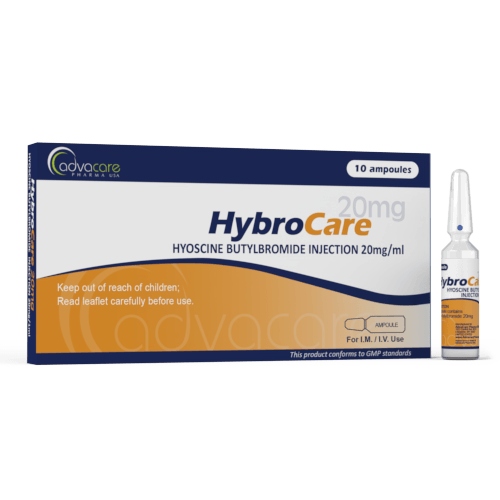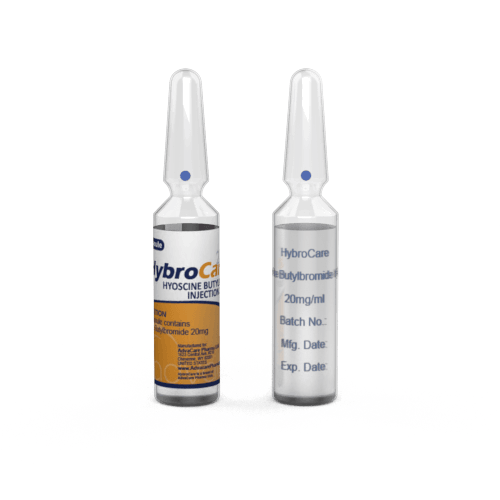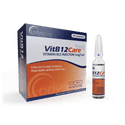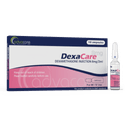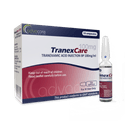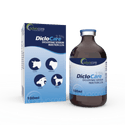- Home›
- Pharmaceuticals›
- Injections›
- Small Volume Injections›
- Hyoscine Injection
Hyoscine Injection
Dosage
Packaging
What is Hyoscine?
Active Ingredients: Hyoscine Butylbromide
Hyoscine Butylbromide Injection is an antispasmodic drug used to treat pain and discomfort caused by abdominal cramps, menstrual cramps, or other spasmodic activity in the digestive system. Injections of this medication are typically used as a diagnostic tool to relax these types of spasms during procedures.
During palliative care, this medication is indicated to treat inoperable bowel obstructions with colic and to dry out secretions in the chest.
Hyoscine Butylbromide is a peripherally acting antimuscarinic/anticholinergic agent. It works by relaxing the muscles of the gastrointestinal and urinary systems.
Hyoscine Butylbromide is also known as Butylscopolamine.
This drug is a quaternary ammonium derivate that has an effect on the smooth muscle of the gastrointestinal, urinary, and biliary tracts. This drug does not enter the central nervous system and there are no side effects on the CNS due to the administration of this drug. This drug has a ganglion blocking action and antimuscarinic activity and has a peripheral anticholinergic effect.
After parenteral administration, this drug is rapidly distributed into the tissues. It has a high affinity for the muscarinic and nicotinic receptors, and it is mainly distributed on muscle cells in the abdominal and pelvic area. It is also distributed in the intramural ganglia of the abdominal organs. The plasma protein binding of this drug is around 4.4%. After intravenous injections, 42 to 61% of the drug is excreted through the kidneys in the form of urine, and 28.3 to 37% is excreted faecally. This drug is excreted unchanged at approximately 50%.
This drug is also available in the form of tablets.
AdvaCare Pharma is a global distributor and manufacturer of Hyoscine Butylbromide Injections. We offer a wide range of high-quality and cost-effective medications that are available for distribution. Our medications are produced in our GMP-certified facilities in China, India, and the USA.
Why are we a leading Hyoscine manufacturer?
AdvaCare Pharma, a US-owned pharmaceutical company, is a manufacturer of Hyoscine Butylbromide Injection with GMP-compliant manufacturing facilities located worldwide. We conduct frequent GMP, third-party and internal facility inspections to ensure that our manufactured injectable treatments exceed the stringent requirements of importing countries and our distributors.
As a renown Hyoscine Butylbromide manufacturer and global supplier of 120+ pharmaceutical injection products, our global reach extends to over 65 markets ensuring that pharmaceutical distributors, hospitals, pharmacies, NGOs and government institutions receive the quality-assured treatments they need.
Uses
What is Hyoscine used for?
It is used to relieve pain that is caused by spasms in the gastrointestinal and urinary systems. It is used in the treatment of irritable bowel syndrome (IBS) and diverticular disease. It is also used as a diagnostic tool to relax smooth muscle spasms during procedures.
What dose should be given?
The usual dose for adults over 12 years is 20-40mg given by IV several times a day. The maximum dose for adults is 100mg in a day. It can be administered by slow intravenous, intramuscular, or subcutaneous injections several times per day.
The usual dose for children is 0.3-0.6mg/kg, given by IV several times a day. The maximum dose for children is 1.2mg/kg in a day. It can be administered by slow intravenous, intramuscular, or subcutaneous injections several times per day.
Prolonged treatment with Hyoscine Butylbromide Injection is not recommended without investigating the cause of abdominal pain.
Refer to a doctor or pharmacist for guidelines on dosage.
Can Hyoscine be used during pregnancy?
There is no adequate data about the safety of this drug. Animal studies do not show any adverse effects on the reproductive system due to Hyoscine Butylbromide administration during pregnancy. Like any other drug, this drug should be used only when necessary during pregnancy. It should be administered only if the benefits outweigh the risks.
Can Hyoscine be used in nursing mothers?
There is no adequate data that shows the safety of this drug in lactating women. There is no information on this drug, and its metabolites are found in human milk. This drug should be used with caution in women who are breastfeeding.
Is only Hyoscine enough to treat spasms in the gastrointestinal and urinary systems?
It depends on the cause of the spasms. In some mild cases, only this drug can lead to significant relieve. Some severe cases require intensive treatment. The treatment process should be suggested by a professional.
Does Hyoscine Injection have effects on the ability to drive and use machines?
There are no studies that prove that this drug affects the human’s ability to drive and operate some machines, but some patients might experience undesirable effects such as dizziness during the treatment with these injections. Patients should be warned about the possibility of decreased ability while driving and operating machines. If patients have some visual accommodation disturbances, they should avoid driving. This should last until the vision of the patient is repaired.
Other warnings
When the cause of spasms in the urinary and gastrointestinal symptoms are not determined, side effects like fever, nausea, vomiting, abdominal tenderness, changed bowel movements, decreased blood pressure, blood in stool, and fainting might occur.
This drug can lead to drowsiness, and these patients should not drive or operate machinery.
Patients who take this drug should not consume alcohol. Patients with visual accommodation disturbances should not drive or operate machinery after parenteral administration. This should last until the vision of the patients is normalized.
This drug might lead to a risk of anticholinergic complications. It should be administered with caution in patients with narrow-angle glaucoma, intestinal or urinary outlet obstruction, and patients with tachyarrhythmia. These patients might have an elevation of the intraocular pressure. Patients who develop red eyes that are painful or have a loss of vision should seek immediate help from a professional.
After the administration of Hyoscine Butylbromide Injection, patients should be carefully observed. If the patients have symptoms of anaphylaxis, the treatment should be stopped immediately.
Patients who take this drug and have severe cardiac health problems should be monitored. This drug can cause tachycardia, anaphylaxis, and hypotension in patients with severe cardiac health issues.
Side Effects
As with all pharmaceuticals, some unwanted effects can occur from the use of Hyoscine Butylbromide Injection.
Common side effects include, but may not be limited to:
- temporary blurred vision
- constipation
- diarrhea
- decreased perspiration
- dizziness
- thirst
- flushing
- nausea
Serious side effects may include: • signs of an allergic reaction
Adverse events are ranked under headings of frequency using the following convention:
- Very common ≥ 1/10
- Common ≥ 1/100, < 1/10
- Uncommon ≥ 1/1,000, < 1/100
- Rare ≥ 1/10,000, < 1/1,000
- Very rare < 1/10,000
- Not known cannot be estimated from the available data
Immune system disorders include anaphylactic shock, including fatal outcomes, anaphylactoid reactions, dyspnoea, skin reactions (e.g., urticaria, rash, erythema, pruritus), and other hypersensitivity. The frequency of these side effects is not known.
Eye disorders like accommodation disorders, including mydriasis and increased intraocular pressure, have a not known frequency.
Cardiac disorders like tachycardia have a common frequency.
Vascular disorders like decreased blood pressure, dizziness, and flushing have a not known frequency.
Gastrointestinal disorders like dry mouth have a common frequency.
Skin and subcutaneous tissue disorders like dyshidrosis and abnormal sweating have a not known frequency.
Renal and urinary disorders like impaired micturition and urinary retention have a not known frequency.
Nervous system disorders like hallucinations, dystonia, confusion, agitation, and dizziness have a very rare frequency.
For a comprehensive understanding of all potential side effects, consult a medical professional.
If any symptoms persist or worsen, or you notice any other symptoms, please call your doctor.
Precautions
Do NOT use Hyoscine Butylbromide Injection if:
- You are allergic to hyoscine or any other ingredient.
- You have stomach, intestinal, or heart problems.
- You are fructose intolerant.
- You have glaucoma, myasthenia gravis, paralytic ileus, tachycardia, hypertrophy with urination retention, megacolon, or pyloric stenosis.
- You have a mechanical stenosis in the gastrointestinal tract
This drug should not be administered parenterally for the following health problems:
- untreated narrow-angle glaucoma
- tachycardia
- prostate hypertrophy with urinary retention
This drug should not be administered in patients who take anticoagulant drugs because it will increase the risk of intramuscular hematoma.
This drug should not be combined with tri- and tetracyclic antidepressants, antihistamines, antipsychotics, quinidine, amantadine, disopyramide, and other anticholinergics (e.g. tiotropium, ipratropium, atropine-like compounds). These drugs have anticholinergic effects, and Hyoscine Butylbromide can intensify their effect. Dopamine antagonists like metoclopramide may lead to a diminution of the effects of both drugs in the gastrointestinal system of humans. Beta-adrenergic agents should be used with caution because a combination of those drugs with Hyoscine Butylbromide can lead to intensified tachycardic effects.
Before treatment, consult your doctor regarding any medications you are taking to address potential drug interactions.Patients should inform their doctors about any prescribed or unprescribed drugs they are taking.
This medication may not be suitable for people with certain conditions, so it is important to consult with a doctor if you have any health conditions.
Hyoscine Butylbromide 10mg: Why the most common dose?
Hyoscine Butylbromide 10mg is used because it provides effectual relief from abdominal cramps and spasms with minimal side effects. This dosage is optimal for reducing smooth muscle spasms in the gastrointestinal and urinary tracts, ensuring quick symptom relief and improved patient comfort.
References
Hyoscine butylbromide – a review on its parenteral use in acute abdominal spasm and as an aid in abdominal diagnostic and therapeutic procedures
This study focuses on the therapeutic efficacy and safety of the parenteral administration of Hyoscine butylbromide (HBB) for treating biliary and renal colic and acute spasm in the genito-urinary tract.
In the majority of clinical trials, recommended doses of 20-40mg of HBB were administered, primarily via intravenous injection. HBB swiftly alleviates pain in renal colic, with approximately 90% of patients experiencing good to moderate analgesic effects within 30 minutes, with noticeable relief setting within 10 minutes. This drug also shows a reduction in pain, ranging from 42% to 78%, which was observed within 30 minutes following a single intravenous injection of 20mg in patients with biliary colic.
This study indicates that HBB has rapid action and beneficial efficacy combined with good tolerability in patients who have acute abdominal spasms, are in labor and palliative care patients. It can also be a supportive drug during diagnostic and therapeutic abdominal procedures, where spasms may be a problem.

You might be interested in...
Why AdvaCare Pharma?
As an industry leader, we are aware of our responsibility to provide affordable and sustainable solutions to improve healthcare worldwide.
